Posts Tagged ‘R Lalique Architecture – Rene Lalique Architecture’
Rene Lalique Sales Records: Highest Selling Lalique Auction Total In History With Just 16 R. Lalique Lots
February 18th, 2013
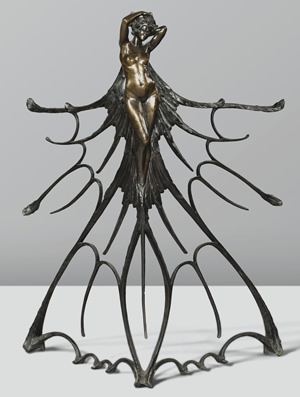 There’s no more appropriate place for the sale of great R. Lalique items than Paris. Rene Lalique spent most of his life in Paris. He lived and died in perhaps the greatest of the European metropolises. Most of his inspired and unique works were created there, and it was there in 1900 and again in 1925 that Lalique rose above the fray; rose above the crowded field of artists and designers, and left his contemporaries behind as he captured the attention and the imagination of the world. There’s no more appropriate place for the sale of great R. Lalique items than Paris. Rene Lalique spent most of his life in Paris. He lived and died in perhaps the greatest of the European metropolises. Most of his inspired and unique works were created there, and it was there in 1900 and again in 1925 that Lalique rose above the fray; rose above the crowded field of artists and designers, and left his contemporaries behind as he captured the attention and the imagination of the world.
Many of his works, both unique and commercial show a heavy Japanese artistic influence. In a way, you could predict that perhaps the greatest of all French decorative artists, growing up in the rich pastoral countryside would embrace the natural world motif as a primary artistic expression in the same way that countless generations of Japanese artists had done before him.
 But you could not predict the new heights to which Lalique would take this traditional expressive motif, as he applied his interpretation of the surrounding world not only to artistically unique objects, but also to the mass production of the new art glass which he brought into the homes of so many people around the world. Echoing an old 20th century American summer camp fireside story, the “foo is on the other shoot”. For today, a whole new generation of eastern artists is trying to build upon the works of the great Frenchman; works that stand squarely on the shoulders of their own native ancestral designers. But you could not predict the new heights to which Lalique would take this traditional expressive motif, as he applied his interpretation of the surrounding world not only to artistically unique objects, but also to the mass production of the new art glass which he brought into the homes of so many people around the world. Echoing an old 20th century American summer camp fireside story, the “foo is on the other shoot”. For today, a whole new generation of eastern artists is trying to build upon the works of the great Frenchman; works that stand squarely on the shoulders of their own native ancestral designers.
So it is only fitting that the collection of Tokeo Horiuchi, the enthusiastic collector of turn of the century French decorative art; art which so clearly echoes the motifs of his homeland, would be destined for sale not in Tokyo, a center of high level natural world artistic efforts for so many long past generations, but would instead be brought to Paris, the scene, the home and the leading light of the great wave of the genre that brought Lalique’s work not just to one city or one country, but to most of the civilized world.
It’s also fitting that in a sale heavily laden with so many of the names you would expect to hear when assembling an entourage of the great decorative arts achievers of the day; names like Brandt, Cartier, Baccarat, Daum, Dunand, Frere, Galle, Guimard, Jallot, Majorelle, Sevres, Mackintosh and Morris; that the high seller in such a sale would be a non-commercial object made for the very 1900 exposition which was the foundation event for the assemblage. Yes friends, in the rural Midwestern United States, an area not unfamiliar to this writer, they call it a rail or a railing. And no, when they say rail, they aren’t talking about the bird family that includes the coot, though there are quite a few old coots ** and old railbirds *** back in the Western Reserve ****.
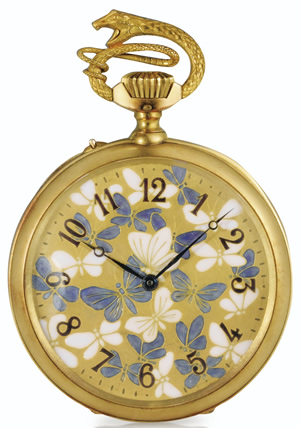 Heck, when you think Midwestern railing, you think of a split piece of timber laying horizontally between two posts somewhere outdoors that keeps your livestock in place, and not exhibition visitors both astonished and at bay. For something like that, you’d need a fancy name and material other than timber, and in Paris for a high seller they had both. Heck, when you think Midwestern railing, you think of a split piece of timber laying horizontally between two posts somewhere outdoors that keeps your livestock in place, and not exhibition visitors both astonished and at bay. For something like that, you’d need a fancy name and material other than timber, and in Paris for a high seller they had both.
Cire perdue bronze, in the form of a nude butterfly woman; a rail piece that can stand on its own with no fence posts needed :). And a railing that can stand on its own when compared artistically and monetarily to the best of the best in the 1900 design world. Oh yea, and it’s not a railing in Paris, it’s a balustrade…. a great French word that means “railing”. So yes, there are thousands of miles of balustrades in the rural midwest, but of course most of the inhabitants (the cows AND the people) can’t speak French so they don’t know it!
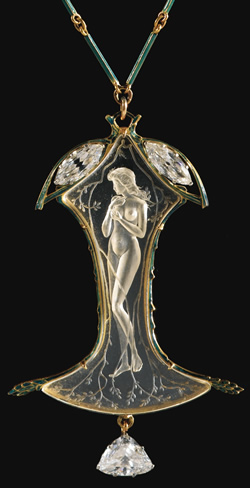 There were 137 lots in the February 16th sale at Sotheby’s, of which 17 were the works of Lalique. Against an estimate of €200,000 – €300,000, the great Femme Ailee rail sold for a hammer price of €1,050,000 and a premium inclusive total of €1,240,750. At today’s exchange rate of about 1.375 dollars to the Euro (a rate used for all other approximate dollar prices in this article), the railing part made $1,706,000. There were 137 lots in the February 16th sale at Sotheby’s, of which 17 were the works of Lalique. Against an estimate of €200,000 – €300,000, the great Femme Ailee rail sold for a hammer price of €1,050,000 and a premium inclusive total of €1,240,750. At today’s exchange rate of about 1.375 dollars to the Euro (a rate used for all other approximate dollar prices in this article), the railing part made $1,706,000.
This same railing had previously sold at Christie’s New York Rockefeller Center Salesrooms as Lot 111 on December 10th, 1998 where it made $134,500 including the buyers premium *****. That’s less than 1/12 of the current price! It is one of five railing parts (having three different designs), several of which are shown in an iconic photo of the Lalique display at the 1900 Exhibition Universelle in Paris.
The sale price is likely the 2nd highest price ever achieved at auction for a single work by Rene Lalique, the Lady Trent Doors being the highest. We can safely say it’s the highest price at auction for a Rene Lalique Railing piece and it most definitely was the high selling item in the entire Sotheby’s sale.
Another new high seller for Lalique, and a world record price at auction for a Lalique Pocket Watch, was the very cool Butterflies and Bats Pocket Watch. It was also the 2nd highest selling lot in the entire sale, outselling an amazing Bureau Aux Archidees Louis Majorelle Desk! The small 2 inch wide jewel of a watch made an all-in €696,750 against a pre-sale estimate of €150,000 – €200,000. In dollars it’s about $958,000.
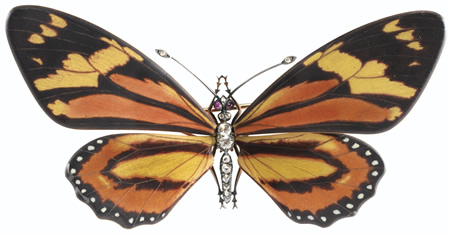
After the watch, things fell off really quickly (just kidding), as the third high seller for Lalique and fourth for the entire auction, the quintessential nude female pendant with comporting chain, sold for €312,750 or about $430,000, once again blowing out the estimated price of €100,000 – €120,000.
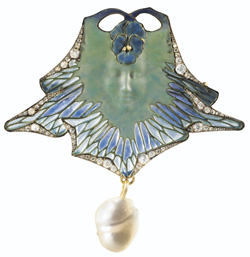 Fourth in line for price honors was the 9 centimeters long and stunningly realistic enamel, gold, silver and diamond Butterfly Brooch which hit €300,750 all-in, or about $413,000 against an estimated price of only €60,000 – €80,000. Fourth in line for price honors was the 9 centimeters long and stunningly realistic enamel, gold, silver and diamond Butterfly Brooch which hit €300,750 all-in, or about $413,000 against an estimated price of only €60,000 – €80,000.
Fifth in the price department was a fabulous and so R. Lalique Brooch featuring the classic Lalique drop baroque pearl under a female face spreading to detailed enamel work. The estimate was €100,000 – €120,000 but the price was €216,750 or about $298,000.
In some ways the most surprising price of the sale was for lot 126, a clear and frosted Sauterelles Vase with patina that against a reasonable to strong estimate of €4000 – €6000 made an all-in €13,750 or about $19,000.
All in all, of the 17 Lalique lots, 16 sold, the only exception being the lowest estimated of them all, a Font-Romeu Vase with heavy patina estimated at €2500 – €3500.
The 16 sellers made €3,410,975 or $4,690,000 making this the highest selling group of R. Lalique at any single auction in history. Quality not quantity was key. Furthermore, every one of the 16 lots that sold made an all-in total that exceeded its high estimate. The average price for the sold lots was €213,186 or $293,000. An amazing group of numbers and another great day for the great Rene Lalique.
** In the U.S., an “old coot” is a kind of a simple minded harmless older person. But you can add some words like crazy or senile to the beginning to give it a more robust and a bit less harmless meaning.
*** A “rail bird” is a member of the rail bird family, which as we mentioned includes coots. But if you put the two words together, “railbird” in the U.S. is any sports enthusiast, but specifically a horse-racing fan who sits on, leans on, or hangs out near the track rail at horse races or workouts.
**** At the time of the founding of the USA, the 13 colonies agreed to compromise many of the land claims found in their original land grants, specifically the ones that gave them all the land to the next ocean. In return the new government assumed the States’ debts from the Revolutionary War. When Connecticut gave up its expansive land claims, it retained a claim to over 3,300,000 acres on some land in the Northwest Territory that was set aside for future settlement including land reserved for those who lost their homes in the war. That land, which now comprises part of Northern Ohio, was (and still is) called the Western Reserve; land reserved in the west. If you go there today, and head out east of Cleveland (named after the head of the Connecticut Land Company survey crew Moses Cleaveland … a printer dropped the first “a” from his name to save space) to Chagrin Falls and the Chagrin River Valley, you’ll find an amazing idyllic architectural and geographic make-up very much like the old Connecticut countryside. And if were wondering, 3,300,000 acres would equal nearly 6% of the entire UK.
***** The sale catalogue from the 1998 Christie’s New York Sale on December 10, 1998 is available for purchase (including the sales results) in the Decorative Arts Catalogues section in the Library here at RLalique.com. This Library section alone has nearly 500 different auction catalogues of sales, all of which include some Rene Lalique works in the catalogue. These are in addition to the separate Library section which is devoted to totally Lalique Auction Catalogues. Over 100 of those are listed there for sale.
Tags: R Lalique Architecture - Rene Lalique Architecture, R Lalique Rene Lalique Auctions News and Results, Rene Lalique Jewelry and R Lalique Jewelry
Posted in R Lalique and Rene Lalique Auction News and Results | 1 Comment »
Lalique Poissons Vase in Red Rene Lalique Glass Makes Another R. Lalique Record Price At Auction
April 24th, 2012
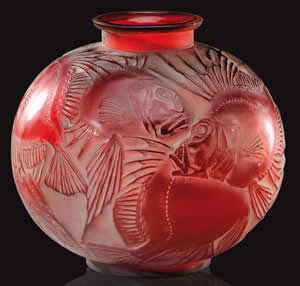 Rene Lalique items continue to get strong prices throughout the world at auction, a good-looking Red Poissons Vase on April 4th in Paris being no exception. Aguttes auction house offered a nice selection of around 15 R. Lalique items at their sale of 20th Century Decorative Arts that day, with the high seller being a Console Table made by Charles Bernel from drawings by Rene Lalique for the Lalique Pavilion at the 1925 Art Deco Exposition In Paris. The rectangular marble table with carved supports made just over €50,000 all in. Rene Lalique items continue to get strong prices throughout the world at auction, a good-looking Red Poissons Vase on April 4th in Paris being no exception. Aguttes auction house offered a nice selection of around 15 R. Lalique items at their sale of 20th Century Decorative Arts that day, with the high seller being a Console Table made by Charles Bernel from drawings by Rene Lalique for the Lalique Pavilion at the 1925 Art Deco Exposition In Paris. The rectangular marble table with carved supports made just over €50,000 all in.
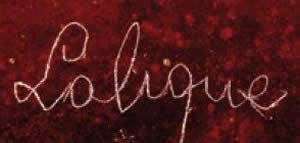 But it’s the next high seller, at €41,628 all-in against a pre-sale estimate of €16,000 – €18,000 that is most interesting in terms of the current market. That price was paid for Lot 67, the patinated red glass Lalique Vase covered with fish. The price for the Poissons Vase translates into about $55,000 which is almost certainly a record price for a Red Poissons at auction. The Lalique signature shown here was inscribed on the vase. But it’s the next high seller, at €41,628 all-in against a pre-sale estimate of €16,000 – €18,000 that is most interesting in terms of the current market. That price was paid for Lot 67, the patinated red glass Lalique Vase covered with fish. The price for the Poissons Vase translates into about $55,000 which is almost certainly a record price for a Red Poissons at auction. The Lalique signature shown here was inscribed on the vase.
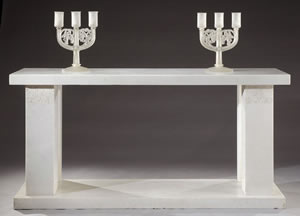 Third high seller in this same sale was a great looking rare candelabra pair in the model Trois Branches Raisins, selling for €31,627 all-in. Third high seller in this same sale was a great looking rare candelabra pair in the model Trois Branches Raisins, selling for €31,627 all-in.
The sale of the good looking R. Lalique Poissons Vase makes yet another mark on the trail of higher and higher prices. We’ve written previously about the demand and pricing for Rene Lalique glass when Lalique buyers see red, but this price strength, fueled by worldwide bidding interest at auctions, is evident across much of the collecting field. Once again, another great result and a great day for the great Rene Lalique.
Tags: R Lalique Architecture - Rene Lalique Architecture, R Lalique Rene Lalique Auctions News and Results, R Lalique Vases and Rene Lalique Vases
Posted in R Lalique and Rene Lalique Auction News and Results | No Comments »
Rene Lalique Doors: World Record Price For Lalique at Auction! R. Lalique Sales Knock Down Doors And Records!
November 23rd, 2011
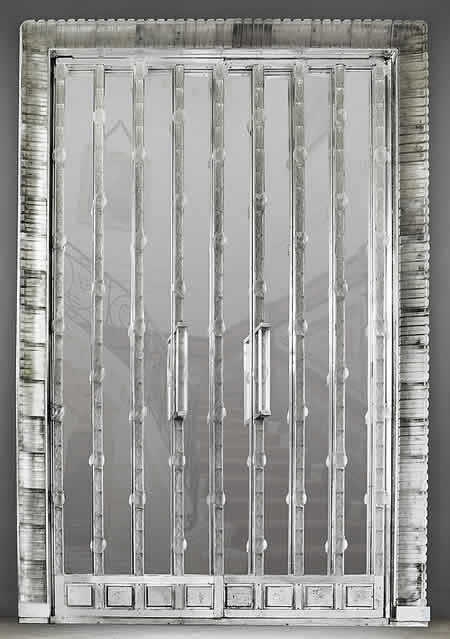
The great R. Lalique Moineaux Chambranle Crante Doors from Villa Millbrook, the Jersey home of Lady Trent sold as Lot 131 on November 22nd at Sotheby’s in Paris at their sale Arts Décoratifs du XXe siècle & Design Contemporain. Against a pre-sale estimate of €400,000 – €600,00, the final hammer price was €1,750,000 which totaled €2,024,750 including buyers premium, or approximately $2,750,000 at today’s exchange rates. This great R Lalique result is a world record price for a single Rene Lalique work at auction!
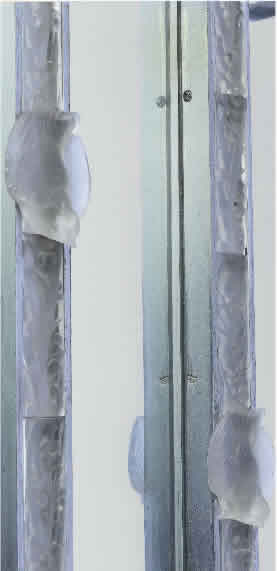 The wonderful glass and nickel plated steel frame double doors were exhibited in 1929 both at the Salon de la Société des Artistes Décorateurs in Paris, and also at Breves Galleries the same year. They were then installed in the home of Lady Trent, the patron for the famous Lalique Glass Church of Jersey architectural commission which stands to this day as a monument to the great Lalique! The wonderful glass and nickel plated steel frame double doors were exhibited in 1929 both at the Salon de la Société des Artistes Décorateurs in Paris, and also at Breves Galleries the same year. They were then installed in the home of Lady Trent, the patron for the famous Lalique Glass Church of Jersey architectural commission which stands to this day as a monument to the great Lalique!
To find out more about Rene Lalique and his architectural creations, from the following link you can access all of the Rene Lalique Architectural content here at RLalique.com including past Lalique Architectural auction results as well as news and reference articles.
Tags: R Lalique and Rene Lalique News, R Lalique Architecture - Rene Lalique Architecture, R Lalique Rene Lalique Auctions News and Results
Posted in R Lalique and Rene Lalique Auction News and Results | No Comments »
R Lalique Express Rolls On: Rene Lalique Train Panels Track Well In Paris With Great Lalique Results
October 1st, 2011
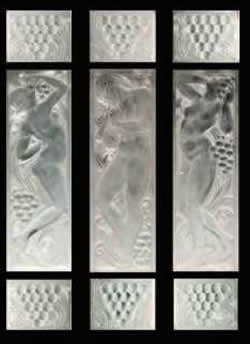 Rene Lalique results at Christie’s Paris “L’âge d’or du rail – Souvenirs de la Compagnie Internationale des Wagons-lits” were oriented towards the high end, continuing a long string of generally very strong sales prices at auction for the works of the Great Lalique. This strong price trend has been in place for several years, and the rare Lalique items in this train related sale conducted by Christie’s followed and extended that trend. Rene Lalique results at Christie’s Paris “L’âge d’or du rail – Souvenirs de la Compagnie Internationale des Wagons-lits” were oriented towards the high end, continuing a long string of generally very strong sales prices at auction for the works of the Great Lalique. This strong price trend has been in place for several years, and the rare Lalique items in this train related sale conducted by Christie’s followed and extended that trend.
Christie’s offered up 12 late 1920’s designed Rene Lalique Architectural Panel Lots and one related lot of a pair of the model of armchairs used for train compartments with fabric by Suzanne Lalique (which made €11,250 all-in, or “all-aboard” *** one might say, which is the case for all prices mentioned in this article). The armchair Lot and Lot 147, the maquette for a compartment for a sleeping car with mahogany and decorative inset panels, both sold to the new Musee Lalique, the latter being pre-empted by the Musee at the low estimate.
The wonderful Rene Lalique wood and glass panels rarely come up at auction, and are usually fiercely competed for when they appear. Sept 27th, 2011 was no exception.
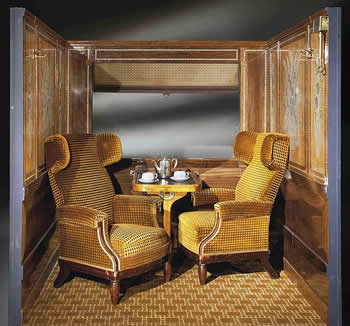 The intrigue amongst the various competing interested parties for rare and high quality R Lalique at auction is often worthy of Orient Express plot status. In this rare instance some of the offered items themselves can also be said to have reached that plot level as well. The intrigue amongst the various competing interested parties for rare and high quality R Lalique at auction is often worthy of Orient Express plot status. In this rare instance some of the offered items themselves can also be said to have reached that plot level as well.
The Lalique train lots were 143 thru 155, and things got rolling right out of the station with Lot 143 (pictured), the 9 piece glass panel Figurines Et Raisins making the high R. Lalique sale price of €133,000. This would prove to be the high price not just of any R Lalique panel in the sale, but the high selling lot of the auction as well.
 This was followed by the decorated wood with glass inserts panel Bouquet De Fleurs which at roughly 32 inches by 15 inches, made €67,000. Lot 148, another slightly different 9 piece Figurines Et Raisins Panel, got what would turn out to be 2nd place in the Lalique high sales compartment at €91,000, and the third high selling lot of the entire auction. Fourth place for R Lalique went to Lot 147 (pictured), a restored maquette for a compartment featuring R. Lalique panels, which made €53,800. This was followed by the decorated wood with glass inserts panel Bouquet De Fleurs which at roughly 32 inches by 15 inches, made €67,000. Lot 148, another slightly different 9 piece Figurines Et Raisins Panel, got what would turn out to be 2nd place in the Lalique high sales compartment at €91,000, and the third high selling lot of the entire auction. Fourth place for R Lalique went to Lot 147 (pictured), a restored maquette for a compartment featuring R. Lalique panels, which made €53,800.
Also pictured is Lot 151, another Bouquet De Fleurs panel version, roughly 3 feet by 1 foot, which sold for €11,875.
In total the 12 Rene Lalique panel lots made €472,225 (roughly $640,000). This was about 40% above the total high estimates of €344,700, with a 100% sales rate, as all 12 lots sold. The average price per lot was €39,352. These totals and averages exclude Lot 145, the pair of related armchairs mentioned above.
Kudos to Christie’s Paris for engineering another great RLalique sales offering!
*** The phrase “all aboard” originated as a train conductor “get on the train, we’re leaving” warning in the United States. The phrase has nautical origins (which makes sense because in the early 19th century, the majority of the European population in the new world likely arrived by boat :), but was first recorded as being used on trains in 1837 in America, and its use has since spread to other forms of transportation.
Tags: R Lalique Architecture - Rene Lalique Architecture, R Lalique Rene Lalique Auctions News and Results
Posted in R Lalique Ramblings | No Comments »
R.Lalique Glass Church: Rene Lalique Architectural & Religious Lalique Glass: St. Matthew’s Church in Jersey
August 18th, 2011
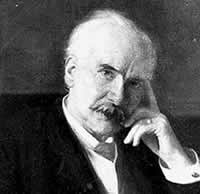 In 1860, the year before the American Civil War started, 10 year old Jesse Boot of Nottingham England began helping his mother run the family medicine shop when his father John died. By age 13 he left school to concentrate on his work in the shop. In the ensuing decades, Jesse would turn the single medicine shop into the major national chain Boots the Chemists. 60 years later in 1920, he sold control of the “Chemists to the Nation” to an American company. Jesse died on the Channel Island of Jersey 11 years later in 1931. In 1860, the year before the American Civil War started, 10 year old Jesse Boot of Nottingham England began helping his mother run the family medicine shop when his father John died. By age 13 he left school to concentrate on his work in the shop. In the ensuing decades, Jesse would turn the single medicine shop into the major national chain Boots the Chemists. 60 years later in 1920, he sold control of the “Chemists to the Nation” to an American company. Jesse died on the Channel Island of Jersey 11 years later in 1931.
Along the way Boot would be knighted Sir Jesse Boot (1909), create a baronet (1917), and in 1929, become Baron Trent of Nottingham, (not as cool as Sheriff, but still a great title:), aka Lord Trent. He did not live to see his son John, the 2nd Baron Trent and his own father’s namesake, re-acquire control of the chain in 1933 in the midst of the depression.
 Boot was also a philanthropist, especially in Nottingham and in Jersey. For one of many examples, he donated the land for what is now the University of Nottingham, which opened in 1928, where the Jesse Boot Chair in Chemistry was named in his honor. Boot was also a philanthropist, especially in Nottingham and in Jersey. For one of many examples, he donated the land for what is now the University of Nottingham, which opened in 1928, where the Jesse Boot Chair in Chemistry was named in his honor.
Boot’s wife, Lady Florence Trent (her maiden name was Florence Rowe) survived him. She kept her principal residence in Jersey, the place they had first met. But Lady Trent also kept a residence on the French Riviera in Cannes, where fortuitously, a famous Frenchman also kept a home; a man who like her deceased husband, had achieved phenomenal success satisfying the new consumer demand created by the industrial revolution. Yes readers, Rene Lalique kept a place in Cannes and was a neighbor of Lady Trent.
In 1932, the year after her husband’s death, Lady Trent asked her neighbor to design new interior fittings in glass for the 1840’s era St. Matthew’s Church of Millbrook located just across the road from her Jersey home which she called Villa Millbrook. It was to be a major architectural undertaking in honor of Baron Trent and Lalique agreed to take the commission. Two years later, in 1934, Lalique’s fabulous undertaking was completed and installed in St. Matthew’s, complemented by additional interior modifications by the Jersey architect A.B. Grayson, an accomplished art deco designer, most notably of private homes.
Lalique glass includes the communion rail, communion table, screens, the altar cross and pillars, a Lalique glass font, window and door panels, and a reredos (altar screen). The art deco Lalique design highlights include angelic figures and Jersey lilies.
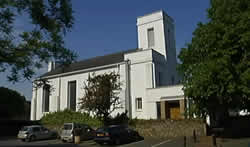
Today St. Matthew’s remains a functioning community place of worship. But owing to the amazing work of the great Lalique, it is better known worldwide as “The Glass Church”. So it’s also an Art Deco treasure of Jersey and a tourist attraction in addition to being a religious establishment.
Last year, the 170 year old Church commenced its first major renovation in over 70 years. The total cost is estimated at £1,000,000. We were alerted to the renovation a year ago through a BBC article which detailed the renovation project and linked out to three reference sources: the “States of Jersey” website, the “Glass Church” website, and to the “Rene Lalique Worldwide Gathering Place”! How great is that? The overhaul is planned to include:
Conservation to the Lalique Glass and the supporting structures of the glass.
New roof.
Restoration of the bell housing and bells.
Replace the electrical wiring and update the lighting.
New heating system.
Interior redecoration and new landscaping.
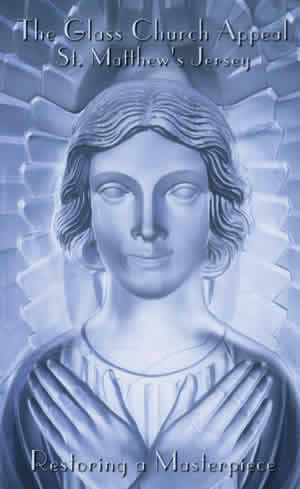 An organization named The Friends of the Glass Church has been set-up under the auspices of the Lieutenant Governor of Jersey, Lieutenant General Andrew Ridgway, to raise funds for the renovations. They have already raised approximately £140,000 toward the project. Updating of the roof was finished in 2010. Also the States of Jersey has approved a matching funds grant of £125,000. Phase two, which is the refurbishment of the bell tower, bells, and some asbestos removal, should be completed in early October, at which time the church will re-open. An organization named The Friends of the Glass Church has been set-up under the auspices of the Lieutenant Governor of Jersey, Lieutenant General Andrew Ridgway, to raise funds for the renovations. They have already raised approximately £140,000 toward the project. Updating of the roof was finished in 2010. Also the States of Jersey has approved a matching funds grant of £125,000. Phase two, which is the refurbishment of the bell tower, bells, and some asbestos removal, should be completed in early October, at which time the church will re-open.
Details of how you can contribute to the project can be found at the Friends of the Glass Church website or the Church’s website, both of which are linked previously. We urge you to consider generously supporting this uniquely Rene Lalique effort.
We spoke with church officials in preparation for this article and were given the following visitor information:
Visitors are welcome at the Church Monday thru Friday from 9:00 AM to 5:30 PM. The Church is closed on Saturdays. Regular services are held on Sunday at 11:00 AM and visitors are welcome to attend.
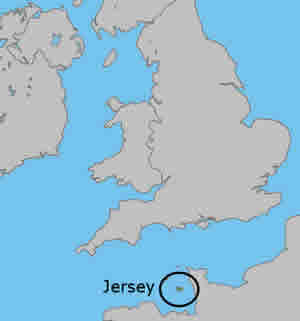 St. Matthew’s home, the island of Jersey has a rich history owing to its location between France and England. It has a population of around 100,000, and both French and English are spoken there. Jersey is a separate possession of the crown; it’s a dependency and not part of the United Kingdom. It even has its own currency, though several other currencies also circulate on the island. It’s a crossroads of cultures and activities. St. Matthew’s home, the island of Jersey has a rich history owing to its location between France and England. It has a population of around 100,000, and both French and English are spoken there. Jersey is a separate possession of the crown; it’s a dependency and not part of the United Kingdom. It even has its own currency, though several other currencies also circulate on the island. It’s a crossroads of cultures and activities.
If you plan to visit, almost everything you ever wanted to know about Jersey can be found at their Jersey.com website, including travel, lodging, attraction and activity choices.
And finally, if you’d like to see many examples of architectural elements created by Rene Lalique, check out the Lalique Architectural Glass page in the R. Lalique Catalog here on the website.
Tags: R Lalique Architecture - Rene Lalique Architecture, Rene Lalique Biography, Rene Lalique History and R Lalique History
Posted in Articles of Interest to Collectors, R Lalique and Rene Lalique History | No Comments »
Rene Lalique Glass Panel Doors: Lalique’s Doors at 40 Cours la Reine – A Lalique Architectural Landmark
February 19th, 2010
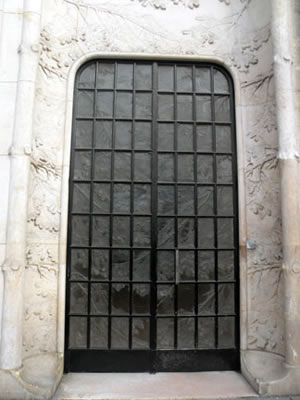 Rene Lalique moved in 1902 to a new residence and workshop at 40 Cours la Reine in Paris. The building was a renovation totaling five floors. The first two floors were show and retail space for Lalique’s expanding business. There was also Lalique’s workshop and Lalique’s residence above. Rene Lalique moved in 1902 to a new residence and workshop at 40 Cours la Reine in Paris. The building was a renovation totaling five floors. The first two floors were show and retail space for Lalique’s expanding business. There was also Lalique’s workshop and Lalique’s residence above.
It was here, that Lalique installed what might be his first and most important architectural statement; the famous Lalique glass panel doors. The doors consisted of glass panels set in a metal frame.
These doors contain a design of pinecones and branches with each panel being a different part of the picture. The relief glass design of the doors continues from the glass panels onto the exterior of the building. It’s also echoed in the railings that rim the windows of the residence!
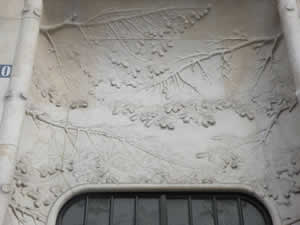 Lalique died at the age of 85 in this same house 43 years later as World War II was coming to and end. Lalique died at the age of 85 in this same house 43 years later as World War II was coming to and end.
Over a century later, the doors remain a quiet yet iconic reminder of the creativity, foresight, and design talent of Rene Lalique. And as Nicholas Dawes notes in his standard reference work “Lalique Glass”, this single creative element incorporated into the exterior decor of his own shop and residence, may have been responsible for many future architectural commissions as potential clients came to the shop and experienced the wonder of the great glass panel doors.
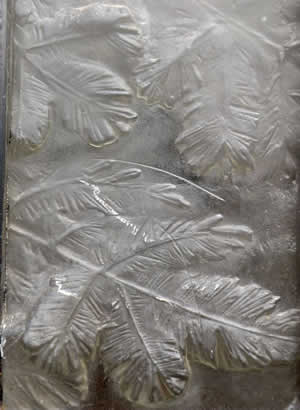 If you are in Paris though, you may have trouble finding the doors at 40 Cours la Reine. Why? Because the street has been renamed to 40 Cour d’Albert! If you are in Paris though, you may have trouble finding the doors at 40 Cours la Reine. Why? Because the street has been renamed to 40 Cour d’Albert!
But worry not if you cannot find or cannot go!
We have found a good-humored guy from the east coast, Richard Nahem, who now lives in Paris and who loves to take photos. Richard has taken some great detailed pictures of the former Lalique residence including the famous Lalique Glass doors. So we thought it would be great to share this bit of Lalique architectural history with you as shown through those photos
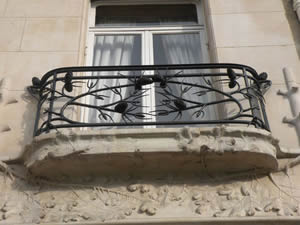 And don’t forget, you can find links to all resources related to Rene Lalique Architecture at RLalique.com in the Rene Lalique Architecture Section of the Lalique Biography. And don’t forget, you can find links to all resources related to Rene Lalique Architecture at RLalique.com in the Rene Lalique Architecture Section of the Lalique Biography.
By the way, Richard runs a very entertaining and informative blog about life in Paris, aptly named eyepreferparis.com! Of course, if this writer were penning a location touting blog, it would likely be named EyePreferHangingOutAtWorldHeadquarters.com!
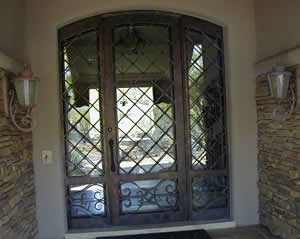 And lest you be left in wonder, yes, World Headquarters is not without its own great glass and metal work door. Notice all the similarities? The great Lalique doors have glass and our door has glass. The great Lalique doors have metal and our door has metal. The Lalique doors open and close and our door opens and closes. Pretty similar right? It’s almost freaky the number of things the World Headquarter door has in common with the Lalique doors. Too bad it can’t hold a candle to* the work of the great Rene Lalique 🙂 Hmmmmm….. And lest you be left in wonder, yes, World Headquarters is not without its own great glass and metal work door. Notice all the similarities? The great Lalique doors have glass and our door has glass. The great Lalique doors have metal and our door has metal. The Lalique doors open and close and our door opens and closes. Pretty similar right? It’s almost freaky the number of things the World Headquarter door has in common with the Lalique doors. Too bad it can’t hold a candle to* the work of the great Rene Lalique 🙂 Hmmmmm…..
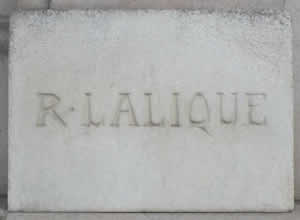 *”Can’t hold a candle to” is an expression from the days before electric lights. When a person had to do some work in the dark, it might require a helper to hold a candle to illuminate the work area. Simple job, holding the candle. Of course, if your skill level or attention level or work ethic was so low that you could not properly perform the task of holding the candle it would put you in a negative light (no pun intended on the light thing). Anyway, can’t hold a candle to whatever, became a phrase to denote low talent or low worthiness by comparison to something else. *”Can’t hold a candle to” is an expression from the days before electric lights. When a person had to do some work in the dark, it might require a helper to hold a candle to illuminate the work area. Simple job, holding the candle. Of course, if your skill level or attention level or work ethic was so low that you could not properly perform the task of holding the candle it would put you in a negative light (no pun intended on the light thing). Anyway, can’t hold a candle to whatever, became a phrase to denote low talent or low worthiness by comparison to something else.
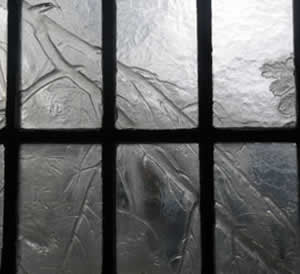 For example, there is no website in the world about Rene Lalique and his works that can hold a candle to RLalique.com! Don’t know how we thought up this great example, it just popped in our heads! For example, there is no website in the world about Rene Lalique and his works that can hold a candle to RLalique.com! Don’t know how we thought up this great example, it just popped in our heads!
Tags: R Lalique Architecture - Rene Lalique Architecture, Rene Lalique Biography, Rene Lalique History and R Lalique History
Posted in Articles of Interest to Collectors, R Lalique and Rene Lalique History | No Comments »
Rene Lalique Fountain Statue: An R Lalique Pigeon! Is this Lalique Glass Bird For The Birds?
November 4th, 2009
Rene Lalique Pigeon Statue From A Fountain! A Lalique Glass Big Bird!
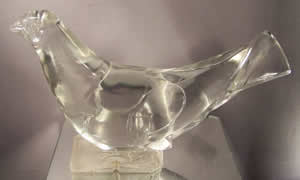 An apparently surviving Rene Lalique statue likely from a long ago disassembled fountain that once occupied a roundabout intersection on the Champs Elysées in Paris has appeared at auction. An R Lalique Bird so rare, it is not shown in the Catalogue Raisonne (except in a photo of the fountain) even as a drawing; though the mate to this bird, the head down pigeon does appear as a drawing in the Catalogue. See page 871 of the 2004 edition. An apparently surviving Rene Lalique statue likely from a long ago disassembled fountain that once occupied a roundabout intersection on the Champs Elysées in Paris has appeared at auction. An R Lalique Bird so rare, it is not shown in the Catalogue Raisonne (except in a photo of the fountain) even as a drawing; though the mate to this bird, the head down pigeon does appear as a drawing in the Catalogue. See page 871 of the 2004 edition.
 The R Lalique Art Deco style Pigeon is quite large, measuring 35 cm in length and 22 cm high. The R Lalique Art Deco style Pigeon is quite large, measuring 35 cm in length and 22 cm high.
The Pigeon fountain element has damage to the base that attached it to its original resting place, but otherwise, seems in pretty good shape from the detailed photos provided by the seller.
Here is a link to a saved/cached image version of the original 170399426823 listing online. You may have to use the zoom function of your browser (or whatever program opens images for you) to get the cached image to expand in the window if it does not appear full size. After clicking on the link to the item, a new window will open with the cached image in it. On a Mac, just click on the image and see if that expands it. If not, press the apple key and click on the cached image in your browser window. On a PC, hold down the alt key while clicking on the cached image.
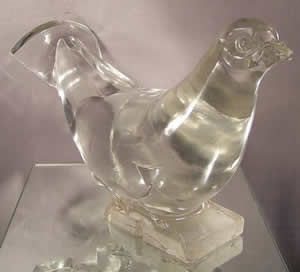 Might be worth taking a flyer** at the current price of around $1140, and maybe some distance north of that amount as well. 🙂 As usual, check it out and satisfy yourself before bidding, not just on the piece, but on the terms (a big bird for international shipping that won’t fly itself to your house)! See our Rene Lalique Auction Buyers Guide for extensive details on bidding at auctions! Might be worth taking a flyer** at the current price of around $1140, and maybe some distance north of that amount as well. 🙂 As usual, check it out and satisfy yourself before bidding, not just on the piece, but on the terms (a big bird for international shipping that won’t fly itself to your house)! See our Rene Lalique Auction Buyers Guide for extensive details on bidding at auctions!
We’ve listed this bird in the Rene Lalique Auctions Worldwide section here on the website. And of course, the out of print and extremely hard to find R.Lalique Catalogue Raisonne is available in the Rene Lalique Books and Library section.
Leave it to the great Rene Lalique to create a pigeon covered fountain that is not also covered by the mess!
* The expression “For The Birds”, also “That’s For The Birds”, and the even more emphatic “Strictly For The Birds”, is an American expression that has not caught on elsewhere. The earliest records of it are from the mid 1940’s, being used as a slang in the US Military! The expression indicates something that is meaningless or worthless, something for gullible people.
** The expression “Take a Flyer” is a mainly American and British expression that means: Take a chance!
Tags: R Lalique Architecture - Rene Lalique Architecture, R Lalique Rene Lalique Auctions News and Results, Rene Lalique Statues Figurines: R Lalique Statues
Posted in R Lalique and Rene Lalique Auction News and Results | No Comments »
Rene Lalique Architecture: The Imperial Family of Asaka, Rene Lalique Glass, and The Tokyo Metropolitan Teien Art Museum
August 16th, 2009
Rene Lalique Architectural Door Panels In the Tokyo Metropolitan Teien Art Museum: How did they get there?
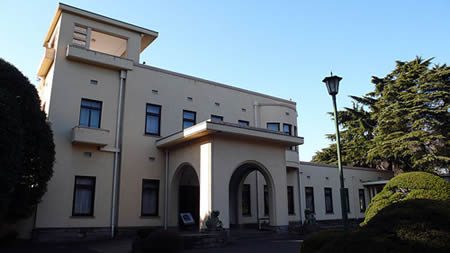
The short version is, they were shipped by boat:), but as usual the whole story is a bit more complicated! We’ll try and keep it brief as usual.
In 1852, Meiji the Great, destined to be the 122nd Emperor of Japan was born with the name Mutsuhito. His birth was less than a year before Admiral Perry would arrive on the scene. In 1867 at the age of 14, he became Emperor of Japan. He had no children with his wife, but had 15 kids with 5 different official consorts. Only five of his children survived childhood. The one of the five we are interested in is Princess Nobuko, the eighth daughter of the Emperor. In 1910 she married the royal Prince Yasuhiko, also an eighth child, who four years earlier had established the Imperial Family of Asaka!
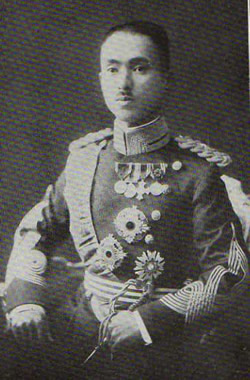 In the early 1920’s, the Prince headed off to Paris for military studies. There he was seriously injured in a car accident in 1923. His wife came to Paris to help nurse him back to health, and they both were still in Paris in 1925 when the 1925 Exposition Internationale Des Arts Decoratifs took the world by storm. Apparently, it took the Asaka family by storm as well, and the new art deco style, decoratif art in everyday life, caught their fancy. In the early 1920’s, the Prince headed off to Paris for military studies. There he was seriously injured in a car accident in 1923. His wife came to Paris to help nurse him back to health, and they both were still in Paris in 1925 when the 1925 Exposition Internationale Des Arts Decoratifs took the world by storm. Apparently, it took the Asaka family by storm as well, and the new art deco style, decoratif art in everyday life, caught their fancy.
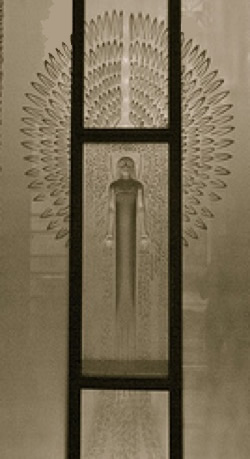 In 1929, they began work on an Art Deco residence in Tokyo that was completed in 1933. While the Ministry of Imperial Household oversaw the design and construction, the input of several of the great French decorative arts practitioners, notably Rene Lalique, and to a larger degree Henri Rapin (to whom the Prince entrusted the interior design of 7 of the rooms), made the house a model of modernist art deco restraint and style. The architectural contributions of Rene Lalique included the glass panel doors, and the chandeliers in the dining hall and grand guest room. In 1929, they began work on an Art Deco residence in Tokyo that was completed in 1933. While the Ministry of Imperial Household oversaw the design and construction, the input of several of the great French decorative arts practitioners, notably Rene Lalique, and to a larger degree Henri Rapin (to whom the Prince entrusted the interior design of 7 of the rooms), made the house a model of modernist art deco restraint and style. The architectural contributions of Rene Lalique included the glass panel doors, and the chandeliers in the dining hall and grand guest room.
Fast forward through a war, the Asaka Family in 1947 lost it’s membership in the Imperial Household, the residence was taken over by the government and put to various government uses, and finally, it was turned over to the Tokyo Metropolitan Foundation For History and Culture, which opened the doors of the Asaka residence as the Tokyo Metropolitan Teien Art Museum in 1983. The Asaka residence had wonderful grounds surrounding it, hence the addition of the word “Teien”, meaning park or gardens, to the name of the museum.
And that is why the great doors and chandeliers of Rene Lalique still exist in their original home today, along with other decorative R Lalique objects, all preserved in the museum.
Over the years, the museum has held many exhibitions, including a great Rene Lalique exhibition in 1988 that is documented extensively in the catalogue book of the exhibition containing about 200 very high quality R Lalique photos. A copy of this rare catalogue book from the exhibition at the former Asaka residence is available in the Rene Lalique Books and Library Section.
What happened to Prince Asaka, the creator of the great art deco residence? He served in the military during World War II (not without some controversy), making the rank of General. After the war he moved to the small city of Atami south of Tokyo where he became an avid golfer. He lived to the age of 93, passing away in 1981!
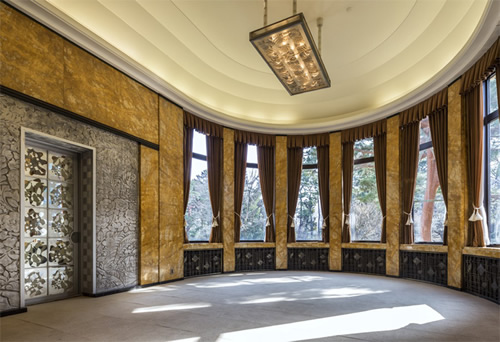
And why are we telling you all this now? Well, it’s great R Lalique history, and more importantly, we stumbled across a great video of the museum, which takes you thru a personal video tour, including looks at some of the works of Rene Lalique which are installed and housed at the former Asaka residence. An in situ look at period works of the great Rene Lalique at the Tokyo Metropolitan Teien Art Museum.
Tags: R Lalique Architecture - Rene Lalique Architecture, R Lalique Exhibitions and Rene Lalique Exhibitions, R Lalique Rene Lalique Exhibitions Sales Catalogs, R Lalique Videos and Rene Lalique Videos, Rene Lalique History and R Lalique History, Rene Lalique Museums: R Lalique Museum Collections
Posted in Articles of Interest to Collectors, R Lalique and Rene Lalique History | No Comments »
Who Bought 30 TONS of R Lalique Glass? A “Castle In The Air” and An American Success Story!
January 10th, 2009
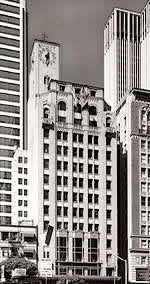 In 1906, James Oviatt left Salt Lake City and headed to Los Angeles to make his fortune. 5 years later in 1911, he partnered up with Frank Alexander to create what would become THE high end fashionable clothing store in Los Angeles: Alexander and Oviatt. In 1906, James Oviatt left Salt Lake City and headed to Los Angeles to make his fortune. 5 years later in 1911, he partnered up with Frank Alexander to create what would become THE high end fashionable clothing store in Los Angeles: Alexander and Oviatt.
Oviatt traveled extensively buying fabrics and keeping up with fashions worldwide to bring his clients the latest and greatest from around the world. 1925 saw Oviatt at the Paris Exposition, where he gave the great Rene Lalique a commission to fabricate the architectural glass for his planned Oviatt Building in Los Angeles, which was to become the first Art Deco building in the city. More than 30 tons of glass made for the new Oviatt Building were shipped thru the Panama Canal and installed all over the 12 story building.
Lalique also created a perfume bottle to commemorate the opening of the building, the distinctive “Le Parfum Des Anges” which is pictured below.
And Oviatt also ordered custom tableware from Lalique, monogrammed with his initials for use in the penthouse. Only a few pieces of this tableware are known to have survived.
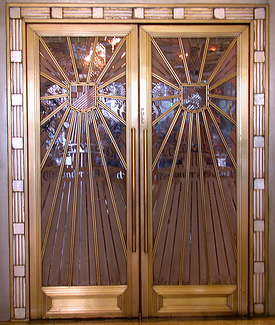 Oviatt and his wife lived on the top of the building, in a 10 room penthouse with two floors of outdoor terraces that became famous not just for the parties and the celebrities that frequently visited there, but also for the magnificent R Lalique glass which can still be found there to this day. The Penthouse terraces had a pool, tennis courts, a sand beach, a putting green, and gardens. Everyone from Howard Hughes to Errol Flynn frequented the penthouse. It was in its day, and it remains 80 years later, an amazing place. The Oviatts lived in the penthouse for nearly 50 years until the mid 70’s. Oviatt and his wife lived on the top of the building, in a 10 room penthouse with two floors of outdoor terraces that became famous not just for the parties and the celebrities that frequently visited there, but also for the magnificent R Lalique glass which can still be found there to this day. The Penthouse terraces had a pool, tennis courts, a sand beach, a putting green, and gardens. Everyone from Howard Hughes to Errol Flynn frequented the penthouse. It was in its day, and it remains 80 years later, an amazing place. The Oviatts lived in the penthouse for nearly 50 years until the mid 70’s.
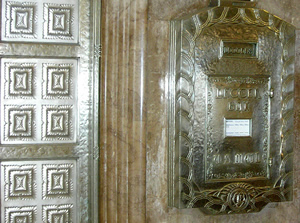 Recently, the penthouse has been magnificently restored, and can be rented for weddings, parties, etc. The original roof top pool is gone, but you can party there both indoors and out with no curfew on your live music. Rumor is that the penthouse is also rented from time to time by LA celebs wanting privacy and an in town get-away. Here is a link to a Video Tour of the Oviatt Penthouse (sorry, it’s from TV Bride, showing the penthouse as a place to rent for a wedding :)! Recently, the penthouse has been magnificently restored, and can be rented for weddings, parties, etc. The original roof top pool is gone, but you can party there both indoors and out with no curfew on your live music. Rumor is that the penthouse is also rented from time to time by LA celebs wanting privacy and an in town get-away. Here is a link to a Video Tour of the Oviatt Penthouse (sorry, it’s from TV Bride, showing the penthouse as a place to rent for a wedding :)!
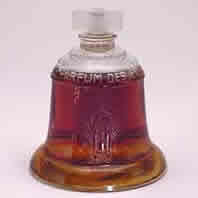 As the building is in the National Register of Historic Places, here is a link to added information at the LA Conservancy. And here is a video about the Modern History of the Oviatt Building. And finally, here is a link to a very Detailed History Of The Building. It is possible to get a tour of the Penthouse under certain circumstances. The Oviatt is an LA Landmark, an Iconic Art Deco Structure, and a lasting testament to the work of Rene Lalique! If you’re in LA and decide to inquire either at the Oviatt or at the Conservancy, don’t forget to tell them you read about it here, at RLalique.com! As the building is in the National Register of Historic Places, here is a link to added information at the LA Conservancy. And here is a video about the Modern History of the Oviatt Building. And finally, here is a link to a very Detailed History Of The Building. It is possible to get a tour of the Penthouse under certain circumstances. The Oviatt is an LA Landmark, an Iconic Art Deco Structure, and a lasting testament to the work of Rene Lalique! If you’re in LA and decide to inquire either at the Oviatt or at the Conservancy, don’t forget to tell them you read about it here, at RLalique.com!
Tags: R Lalique Architecture - Rene Lalique Architecture, Rene Lalique History and R Lalique History
Posted in R Lalique and Rene Lalique History | 1 Comment »
|
 There’s no more appropriate place for the sale of great R. Lalique items than Paris. Rene Lalique spent most of his life in Paris. He lived and died in perhaps the greatest of the European metropolises. Most of his inspired and unique works were created there, and it was there in 1900 and again in 1925 that Lalique rose above the fray; rose above the crowded field of artists and designers, and left his contemporaries behind as he captured the attention and the imagination of the world.
There’s no more appropriate place for the sale of great R. Lalique items than Paris. Rene Lalique spent most of his life in Paris. He lived and died in perhaps the greatest of the European metropolises. Most of his inspired and unique works were created there, and it was there in 1900 and again in 1925 that Lalique rose above the fray; rose above the crowded field of artists and designers, and left his contemporaries behind as he captured the attention and the imagination of the world. But you could not predict the new heights to which Lalique would take this traditional expressive motif, as he applied his interpretation of the surrounding world not only to artistically unique objects, but also to the mass production of the new art glass which he brought into the homes of so many people around the world. Echoing an old 20th century American summer camp fireside story, the “foo is on the other shoot”. For today, a whole new generation of eastern artists is trying to build upon the works of the great Frenchman; works that stand squarely on the shoulders of their own native ancestral designers.
But you could not predict the new heights to which Lalique would take this traditional expressive motif, as he applied his interpretation of the surrounding world not only to artistically unique objects, but also to the mass production of the new art glass which he brought into the homes of so many people around the world. Echoing an old 20th century American summer camp fireside story, the “foo is on the other shoot”. For today, a whole new generation of eastern artists is trying to build upon the works of the great Frenchman; works that stand squarely on the shoulders of their own native ancestral designers. Heck, when you think Midwestern railing, you think of a split piece of timber laying horizontally between two posts somewhere outdoors that keeps your livestock in place, and not exhibition visitors both astonished and at bay. For something like that, you’d need a fancy name and material other than timber, and in Paris for a high seller they had both.
Heck, when you think Midwestern railing, you think of a split piece of timber laying horizontally between two posts somewhere outdoors that keeps your livestock in place, and not exhibition visitors both astonished and at bay. For something like that, you’d need a fancy name and material other than timber, and in Paris for a high seller they had both. There were 137 lots in the February 16th sale at Sotheby’s, of which 17 were the works of Lalique. Against an estimate of €200,000 – €300,000, the great Femme Ailee rail sold for a hammer price of €1,050,000 and a premium inclusive total of €1,240,750. At today’s exchange rate of about 1.375 dollars to the Euro (a rate used for all other approximate dollar prices in this article), the railing part made $1,706,000.
There were 137 lots in the February 16th sale at Sotheby’s, of which 17 were the works of Lalique. Against an estimate of €200,000 – €300,000, the great Femme Ailee rail sold for a hammer price of €1,050,000 and a premium inclusive total of €1,240,750. At today’s exchange rate of about 1.375 dollars to the Euro (a rate used for all other approximate dollar prices in this article), the railing part made $1,706,000.
 Fourth in line for price honors was the 9 centimeters long and stunningly realistic enamel, gold, silver and diamond Butterfly Brooch which hit €300,750 all-in, or about $413,000 against an estimated price of only €60,000 – €80,000.
Fourth in line for price honors was the 9 centimeters long and stunningly realistic enamel, gold, silver and diamond Butterfly Brooch which hit €300,750 all-in, or about $413,000 against an estimated price of only €60,000 – €80,000.
 Rene Lalique items continue to get strong prices throughout the world at auction, a good-looking Red Poissons Vase on April 4th in Paris being no exception. Aguttes auction house offered a nice selection of around 15 R. Lalique items at their sale of 20th Century Decorative Arts that day, with the high seller being a Console Table made by Charles Bernel from drawings by Rene Lalique for the Lalique Pavilion at the 1925 Art Deco Exposition In Paris. The rectangular marble table with carved supports made just over €50,000 all in.
Rene Lalique items continue to get strong prices throughout the world at auction, a good-looking Red Poissons Vase on April 4th in Paris being no exception. Aguttes auction house offered a nice selection of around 15 R. Lalique items at their sale of 20th Century Decorative Arts that day, with the high seller being a Console Table made by Charles Bernel from drawings by Rene Lalique for the Lalique Pavilion at the 1925 Art Deco Exposition In Paris. The rectangular marble table with carved supports made just over €50,000 all in. But it’s the next high seller, at €41,628 all-in against a pre-sale estimate of €16,000 – €18,000 that is most interesting in terms of the current market. That price was paid for Lot 67, the patinated red glass Lalique Vase covered with fish. The price for the Poissons Vase translates into about $55,000 which is almost certainly a record price for a Red Poissons at auction. The Lalique signature shown here was inscribed on the vase.
But it’s the next high seller, at €41,628 all-in against a pre-sale estimate of €16,000 – €18,000 that is most interesting in terms of the current market. That price was paid for Lot 67, the patinated red glass Lalique Vase covered with fish. The price for the Poissons Vase translates into about $55,000 which is almost certainly a record price for a Red Poissons at auction. The Lalique signature shown here was inscribed on the vase. Third high seller in this same sale was a great looking rare
Third high seller in this same sale was a great looking rare 
 The wonderful glass and nickel plated steel frame double doors were exhibited in 1929 both at the Salon de la Société des Artistes Décorateurs in Paris, and also at Breves Galleries the same year. They were then installed in the home of Lady Trent, the patron for the famous
The wonderful glass and nickel plated steel frame double doors were exhibited in 1929 both at the Salon de la Société des Artistes Décorateurs in Paris, and also at Breves Galleries the same year. They were then installed in the home of Lady Trent, the patron for the famous  Rene Lalique results at Christie’s Paris “L’âge d’or du rail – Souvenirs de la Compagnie Internationale des Wagons-lits” were oriented towards the high end, continuing a long string of generally very strong sales prices at auction for the works of the Great Lalique. This strong price trend has been in place for several years, and the rare Lalique items in this train related sale conducted by Christie’s followed and extended that trend.
Rene Lalique results at Christie’s Paris “L’âge d’or du rail – Souvenirs de la Compagnie Internationale des Wagons-lits” were oriented towards the high end, continuing a long string of generally very strong sales prices at auction for the works of the Great Lalique. This strong price trend has been in place for several years, and the rare Lalique items in this train related sale conducted by Christie’s followed and extended that trend. The intrigue amongst the various competing interested parties for rare and high quality R Lalique at auction is often worthy of Orient Express plot status. In this rare instance some of the offered items themselves can also be said to have reached that plot level as well.
The intrigue amongst the various competing interested parties for rare and high quality R Lalique at auction is often worthy of Orient Express plot status. In this rare instance some of the offered items themselves can also be said to have reached that plot level as well. This was followed by the decorated wood with glass inserts panel Bouquet De Fleurs which at roughly 32 inches by 15 inches, made €67,000. Lot 148, another slightly different 9 piece Figurines Et Raisins Panel, got what would turn out to be 2nd place in the Lalique high sales compartment at €91,000, and the third high selling lot of the entire auction. Fourth place for R Lalique went to Lot 147 (pictured), a restored maquette for a compartment featuring R. Lalique panels, which made €53,800.
This was followed by the decorated wood with glass inserts panel Bouquet De Fleurs which at roughly 32 inches by 15 inches, made €67,000. Lot 148, another slightly different 9 piece Figurines Et Raisins Panel, got what would turn out to be 2nd place in the Lalique high sales compartment at €91,000, and the third high selling lot of the entire auction. Fourth place for R Lalique went to Lot 147 (pictured), a restored maquette for a compartment featuring R. Lalique panels, which made €53,800. In 1860, the year before the American Civil War started, 10 year old Jesse Boot of Nottingham England began helping his mother run the family medicine shop when his father John died. By age 13 he left school to concentrate on his work in the shop. In the ensuing decades, Jesse would turn the single medicine shop into the major national chain Boots the Chemists. 60 years later in 1920, he sold control of the “Chemists to the Nation” to an American company. Jesse died on the Channel Island of Jersey 11 years later in 1931.
In 1860, the year before the American Civil War started, 10 year old Jesse Boot of Nottingham England began helping his mother run the family medicine shop when his father John died. By age 13 he left school to concentrate on his work in the shop. In the ensuing decades, Jesse would turn the single medicine shop into the major national chain Boots the Chemists. 60 years later in 1920, he sold control of the “Chemists to the Nation” to an American company. Jesse died on the Channel Island of Jersey 11 years later in 1931. Boot was also a philanthropist, especially in Nottingham and in Jersey. For one of many examples, he donated the land for what is now the University of Nottingham, which opened in 1928, where the Jesse Boot Chair in Chemistry was named in his honor.
Boot was also a philanthropist, especially in Nottingham and in Jersey. For one of many examples, he donated the land for what is now the University of Nottingham, which opened in 1928, where the Jesse Boot Chair in Chemistry was named in his honor.
 An organization named The Friends of the Glass Church has been set-up under the auspices of the Lieutenant Governor of Jersey, Lieutenant General Andrew Ridgway, to raise funds for the renovations. They have already raised approximately £140,000 toward the project. Updating of the roof was finished in 2010. Also the States of Jersey has approved a matching funds grant of £125,000. Phase two, which is the refurbishment of the bell tower, bells, and some asbestos removal, should be completed in early October, at which time the church will re-open.
An organization named The Friends of the Glass Church has been set-up under the auspices of the Lieutenant Governor of Jersey, Lieutenant General Andrew Ridgway, to raise funds for the renovations. They have already raised approximately £140,000 toward the project. Updating of the roof was finished in 2010. Also the States of Jersey has approved a matching funds grant of £125,000. Phase two, which is the refurbishment of the bell tower, bells, and some asbestos removal, should be completed in early October, at which time the church will re-open. St. Matthew’s home, the island of Jersey has a rich history owing to its location between France and England. It has a population of around 100,000, and both French and English are spoken there. Jersey is a separate possession of the crown; it’s a dependency and not part of the United Kingdom. It even has its own currency, though several other currencies also circulate on the island. It’s a crossroads of cultures and activities.
St. Matthew’s home, the island of Jersey has a rich history owing to its location between France and England. It has a population of around 100,000, and both French and English are spoken there. Jersey is a separate possession of the crown; it’s a dependency and not part of the United Kingdom. It even has its own currency, though several other currencies also circulate on the island. It’s a crossroads of cultures and activities. Rene Lalique moved in 1902 to a new residence and workshop at 40 Cours la Reine in Paris. The building was a renovation totaling five floors. The first two floors were show and retail space for Lalique’s expanding business. There was also Lalique’s workshop and Lalique’s residence above.
Rene Lalique moved in 1902 to a new residence and workshop at 40 Cours la Reine in Paris. The building was a renovation totaling five floors. The first two floors were show and retail space for Lalique’s expanding business. There was also Lalique’s workshop and Lalique’s residence above.
 If you are in Paris though, you may have trouble finding the doors at 40 Cours la Reine. Why? Because the street has been renamed to 40 Cour d’Albert!
If you are in Paris though, you may have trouble finding the doors at 40 Cours la Reine. Why? Because the street has been renamed to 40 Cour d’Albert! And don’t forget, you can find links to all resources related to Rene Lalique Architecture at RLalique.com in the
And don’t forget, you can find links to all resources related to Rene Lalique Architecture at RLalique.com in the  And lest you be left in wonder, yes, World Headquarters is not without its own great glass and metal work door. Notice all the similarities? The great Lalique doors have glass and our door has glass. The great Lalique doors have metal and our door has metal. The Lalique doors open and close and our door opens and closes. Pretty similar right? It’s almost freaky the number of things the World Headquarter door has in common with the Lalique doors. Too bad it can’t hold a candle to* the work of the great Rene Lalique 🙂 Hmmmmm…..
And lest you be left in wonder, yes, World Headquarters is not without its own great glass and metal work door. Notice all the similarities? The great Lalique doors have glass and our door has glass. The great Lalique doors have metal and our door has metal. The Lalique doors open and close and our door opens and closes. Pretty similar right? It’s almost freaky the number of things the World Headquarter door has in common with the Lalique doors. Too bad it can’t hold a candle to* the work of the great Rene Lalique 🙂 Hmmmmm….. *”Can’t hold a candle to” is an expression from the days before electric lights. When a person had to do some work in the dark, it might require a helper to hold a candle to illuminate the work area. Simple job, holding the candle. Of course, if your skill level or attention level or work ethic was so low that you could not properly perform the task of holding the candle it would put you in a negative light (no pun intended on the light thing). Anyway, can’t hold a candle to whatever, became a phrase to denote low talent or low worthiness by comparison to something else.
*”Can’t hold a candle to” is an expression from the days before electric lights. When a person had to do some work in the dark, it might require a helper to hold a candle to illuminate the work area. Simple job, holding the candle. Of course, if your skill level or attention level or work ethic was so low that you could not properly perform the task of holding the candle it would put you in a negative light (no pun intended on the light thing). Anyway, can’t hold a candle to whatever, became a phrase to denote low talent or low worthiness by comparison to something else. For example, there is no website in the world about Rene Lalique and his works that can hold a candle to RLalique.com! Don’t know how we thought up this great example, it just popped in our heads!
For example, there is no website in the world about Rene Lalique and his works that can hold a candle to RLalique.com! Don’t know how we thought up this great example, it just popped in our heads! An apparently surviving Rene Lalique statue likely from a long ago disassembled fountain that once occupied a roundabout intersection on the Champs Elysées in Paris has appeared at auction. An R Lalique Bird so rare, it is not shown in the Catalogue Raisonne (except in a photo of the fountain) even as a drawing; though the mate to this bird, the head down pigeon does appear as a drawing in the Catalogue. See page 871 of the 2004 edition.
An apparently surviving Rene Lalique statue likely from a long ago disassembled fountain that once occupied a roundabout intersection on the Champs Elysées in Paris has appeared at auction. An R Lalique Bird so rare, it is not shown in the Catalogue Raisonne (except in a photo of the fountain) even as a drawing; though the mate to this bird, the head down pigeon does appear as a drawing in the Catalogue. See page 871 of the 2004 edition. The R Lalique Art Deco style Pigeon is quite large, measuring 35 cm in length and 22 cm high.
The R Lalique Art Deco style Pigeon is quite large, measuring 35 cm in length and 22 cm high. Might be worth taking a flyer** at the current price of around $1140, and maybe some distance north of that amount as well. 🙂 As usual, check it out and satisfy yourself before bidding, not just on the piece, but on the terms (a big bird for international shipping that won’t fly itself to your house)! See our
Might be worth taking a flyer** at the current price of around $1140, and maybe some distance north of that amount as well. 🙂 As usual, check it out and satisfy yourself before bidding, not just on the piece, but on the terms (a big bird for international shipping that won’t fly itself to your house)! See our 
 In the early 1920’s, the Prince headed off to Paris for military studies. There he was seriously injured in a car accident in 1923. His wife came to Paris to help nurse him back to health, and they both were still in Paris in 1925 when the 1925 Exposition Internationale Des Arts Decoratifs took the world by storm. Apparently, it took the Asaka family by storm as well, and the new art deco style, decoratif art in everyday life, caught their fancy.
In the early 1920’s, the Prince headed off to Paris for military studies. There he was seriously injured in a car accident in 1923. His wife came to Paris to help nurse him back to health, and they both were still in Paris in 1925 when the 1925 Exposition Internationale Des Arts Decoratifs took the world by storm. Apparently, it took the Asaka family by storm as well, and the new art deco style, decoratif art in everyday life, caught their fancy. In 1929, they began work on an Art Deco residence in Tokyo that was completed in 1933. While the Ministry of Imperial Household oversaw the design and construction, the input of several of the great French decorative arts practitioners, notably Rene Lalique, and to a larger degree Henri Rapin (to whom the Prince entrusted the interior design of 7 of the rooms), made the house a model of modernist art deco restraint and style. The architectural contributions of Rene Lalique included the glass panel doors, and the chandeliers in the dining hall and grand guest room.
In 1929, they began work on an Art Deco residence in Tokyo that was completed in 1933. While the Ministry of Imperial Household oversaw the design and construction, the input of several of the great French decorative arts practitioners, notably Rene Lalique, and to a larger degree Henri Rapin (to whom the Prince entrusted the interior design of 7 of the rooms), made the house a model of modernist art deco restraint and style. The architectural contributions of Rene Lalique included the glass panel doors, and the chandeliers in the dining hall and grand guest room.
 In 1906, James Oviatt left Salt Lake City and headed to Los Angeles to make his fortune. 5 years later in 1911, he partnered up with Frank Alexander to create what would become THE high end fashionable clothing store in Los Angeles: Alexander and Oviatt.
In 1906, James Oviatt left Salt Lake City and headed to Los Angeles to make his fortune. 5 years later in 1911, he partnered up with Frank Alexander to create what would become THE high end fashionable clothing store in Los Angeles: Alexander and Oviatt. Oviatt and his wife lived on the top of the building, in a 10 room penthouse with two floors of outdoor terraces that became famous not just for the parties and the celebrities that frequently visited there, but also for the magnificent R Lalique glass which can still be found there to this day. The Penthouse terraces had a pool, tennis courts, a sand beach, a putting green, and gardens. Everyone from Howard Hughes to Errol Flynn frequented the penthouse. It was in its day, and it remains 80 years later, an amazing place. The Oviatts lived in the penthouse for nearly 50 years until the mid 70’s.
Oviatt and his wife lived on the top of the building, in a 10 room penthouse with two floors of outdoor terraces that became famous not just for the parties and the celebrities that frequently visited there, but also for the magnificent R Lalique glass which can still be found there to this day. The Penthouse terraces had a pool, tennis courts, a sand beach, a putting green, and gardens. Everyone from Howard Hughes to Errol Flynn frequented the penthouse. It was in its day, and it remains 80 years later, an amazing place. The Oviatts lived in the penthouse for nearly 50 years until the mid 70’s. Recently, the penthouse has been magnificently restored, and can be rented for weddings, parties, etc. The original roof top pool is gone, but you can party there both indoors and out with no curfew on your live music. Rumor is that the penthouse is also rented from time to time by LA celebs wanting privacy and an in town get-away. Here is a link to a
Recently, the penthouse has been magnificently restored, and can be rented for weddings, parties, etc. The original roof top pool is gone, but you can party there both indoors and out with no curfew on your live music. Rumor is that the penthouse is also rented from time to time by LA celebs wanting privacy and an in town get-away. Here is a link to a  As the building is in the National Register of Historic Places, here is a link to added information at the
As the building is in the National Register of Historic Places, here is a link to added information at the 